Last year Superliga champions Racing Club started their 2019/20 season trailing by four points to the unexpected table leaders Argentinos Jrs by the end of December. There was still a lot to play for and their manager at the time, Eduardo Coudet, despite the struggles in the first half of the season, seemed to be in control and ready to take the club back where it was last season. However, club management and particularly the director of football Diego Milito decided to start fresh and appointed 39-year-old Sebastián Beccacece, who was sacked previously by Independiente. Despite his bad spell for El Rojo, his reputation wasn’t damaged and Racing showed their faith in him.
In the first three months in charge, Beccacece introduced several tactical changes that are very interesting and which guaranteed Racing qualification spot for Copa Libertadores. In this tactical analysis, I will examine the tactics that Beccacece has been implementing during his time in the club.
Build-up strategy
A lot of teams in South American football love to use three at the back in the first line of the build-up. The most common way to approach this is for a defensive midfielder to drop deep and join the two centre-backs while the full-backs push up higher and wider. This concept was extensively used by Mexican national coach La Volpe in the 1990s, and then it spread out to the rest of the football world.
Beccacece hasn’t used three players in the first line during his time in Racing, with the La Academia mainly staying with four initial defenders.
The Argentinian lines his team up in a 4-1-4-1 formation, and this is how their basic set up looks in-game:
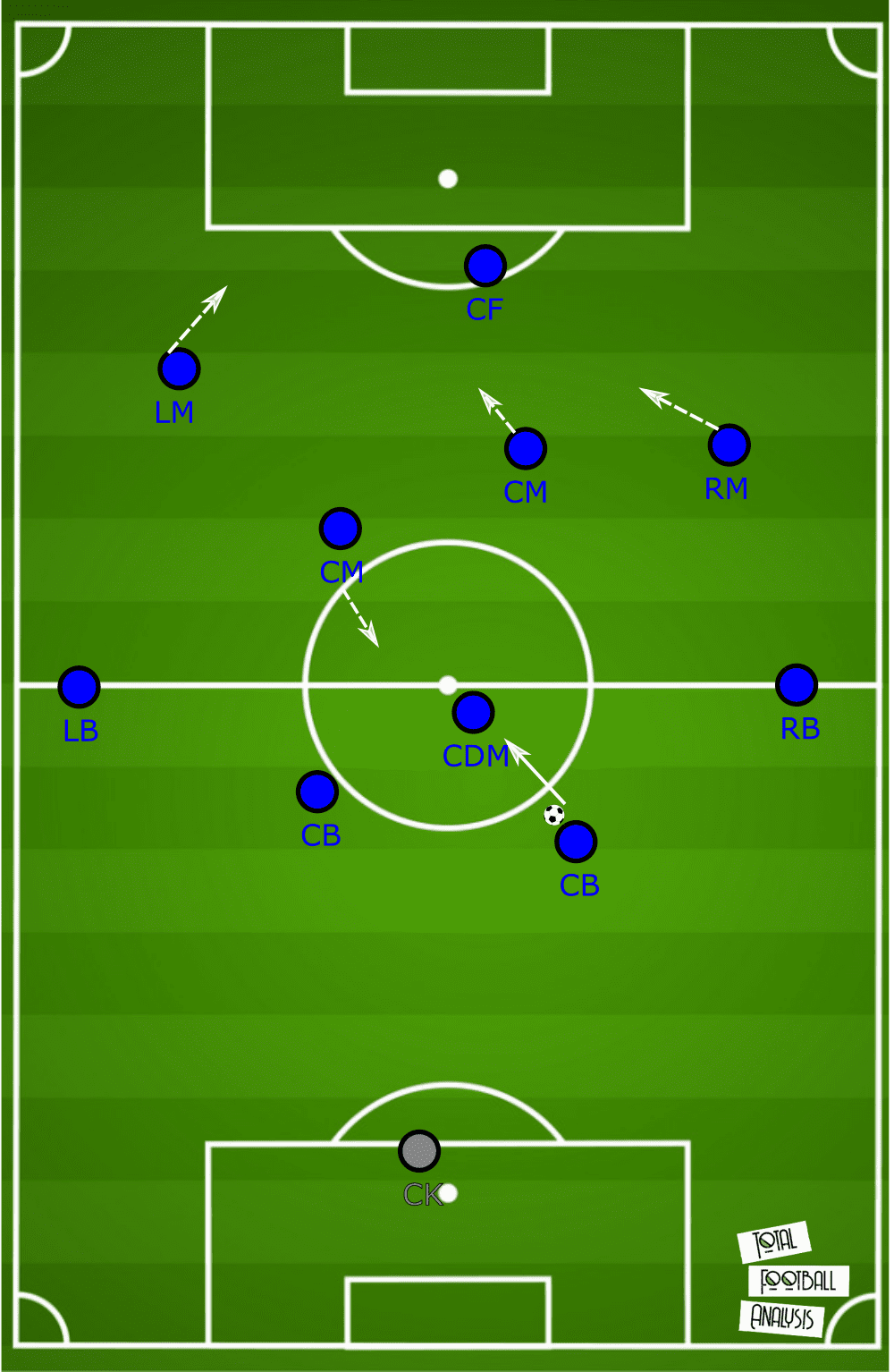
Usually, Miranda plays as the deepest lying midfielder, with two talents Rojas and Zaracho playing as the central midfielders. The backline has not undergone major changes, with Soto and Sigali playing as centre-backs, and with Mena and Pillud in the left- and right full-backs positions respectively. The wide midfielder’s position is the position where the most competition happens, with Montoya and Reniero competing for the right midfield position, and Fertoli occasionally doing the same with Rojas on the left flank.
From the above picture, you can see several patterns of build-up play that Racing use in every game. The four defenders remain in their positions in the beginning, with the defensive midfielder being the focal point of the build-up, getting the ball from defenders and then distributing it to the flanks or playing through the centre. During the build-up phase, full-backs push up higher and wider, with two centre-backs and defensive midfielder having the duty of getting the ball further down the pitch. The wide midfielders drift inside to accommodate full-backs’ movement.
This basic set-up has lots of variations that depend on the situation on the pitch.
Below you can see one of the in-game examples of Racing’s build-up, with two centre-backs leading the backline, full-backs entering the final third, and central midfielders joining the forward in the final third. Defensive midfielder stays with the centre-backs to help circulate the ball and get it into desired areas.
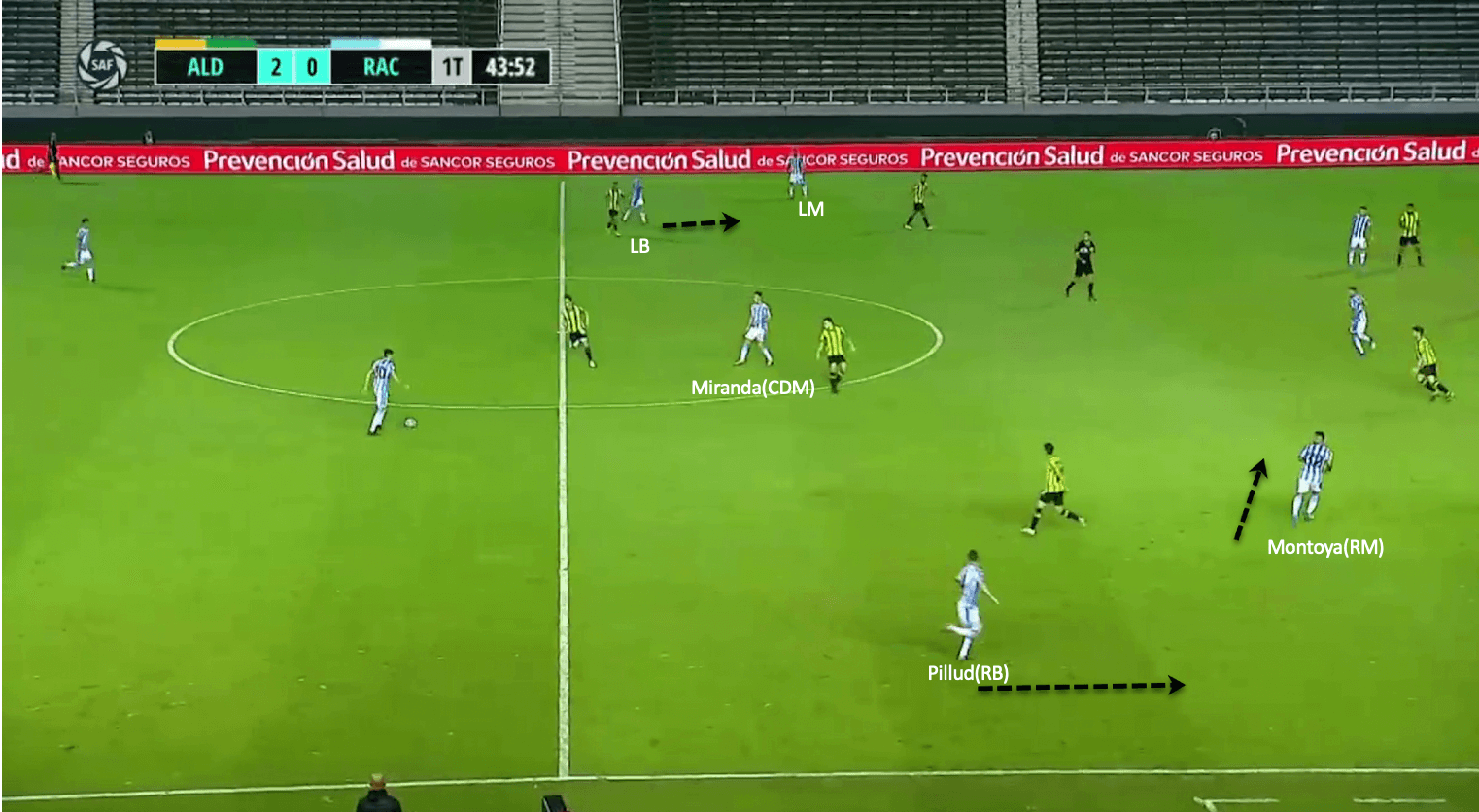
One of the patterns that Beccacece implemented and that helps really well with ball progression is forward runs from centre-backs. Both Sigali and Soto fit this role and executes it well during games. In the shot below Sigali is on the ball, and due to having four players in the backline, he has the opportunity to make a run forward. The left attacker of the opposition is in half-position, ready to press the right-back Pillud if he receives the pass, and not staying too far away from Sigali to be able to press him as well. The left central midfield player is busy with the Racing’s own midfielder, and Aldosivi’s attacker is too late to be able to press Sigali because of simple 2v1 situation. Because of the opposition players being taken out by other Racing players Sigali is able to dribble through the centre and enter the final third.
Even if such an option is not available immediately, players try to work the ball around to get to the position where the centre-backs are able to push up.
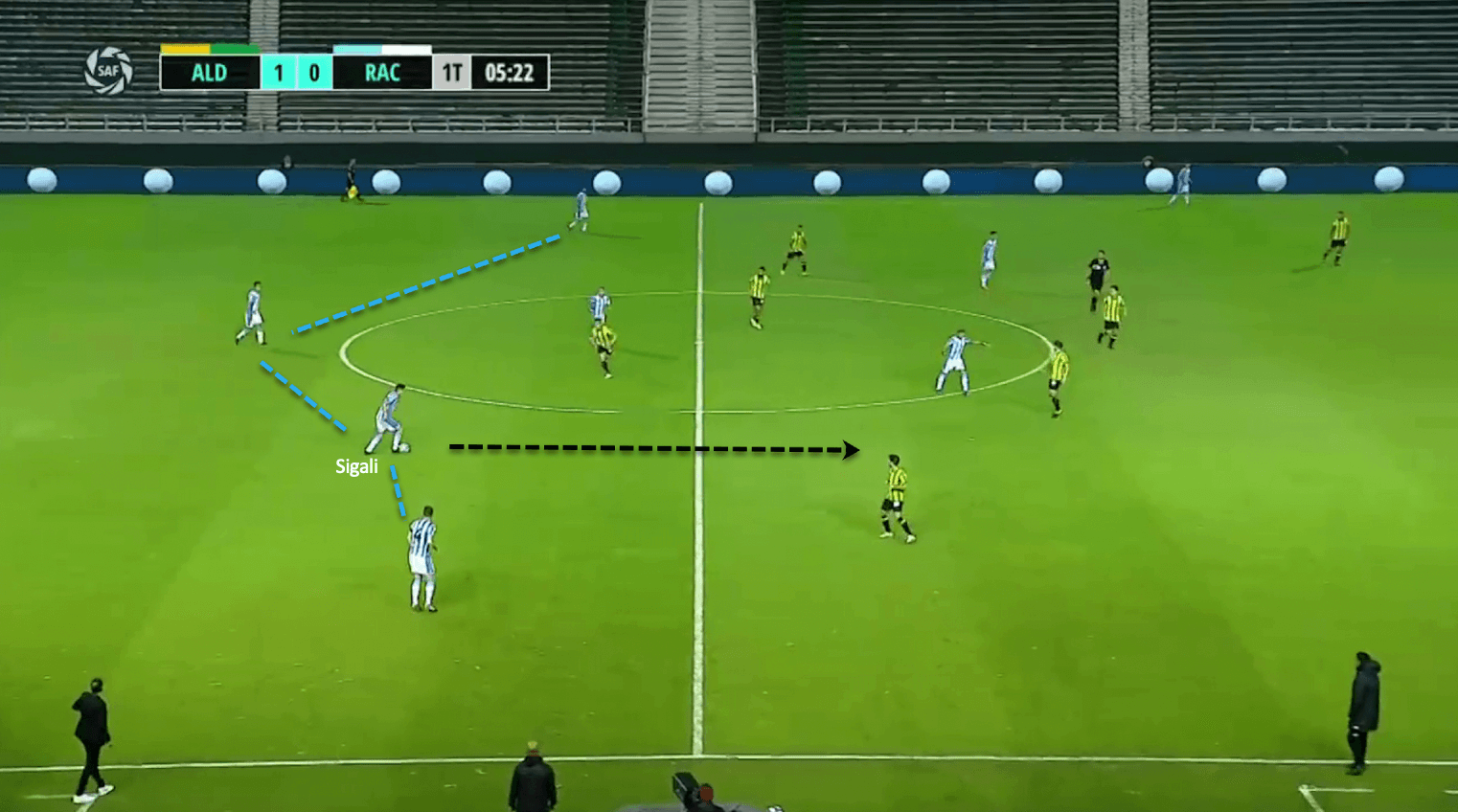
The full-backs are flexible in their roles and can stay in the backline or push forward depending on the situation. In the example below, you can see players’ positioning with Racing’s left-back sticking with the opposition right-back, while left-midfielder drifts inside. Pillud, who wasn’t pushing up from the beginning and seeing the space in front of him, makes a run and creates a great passing option.
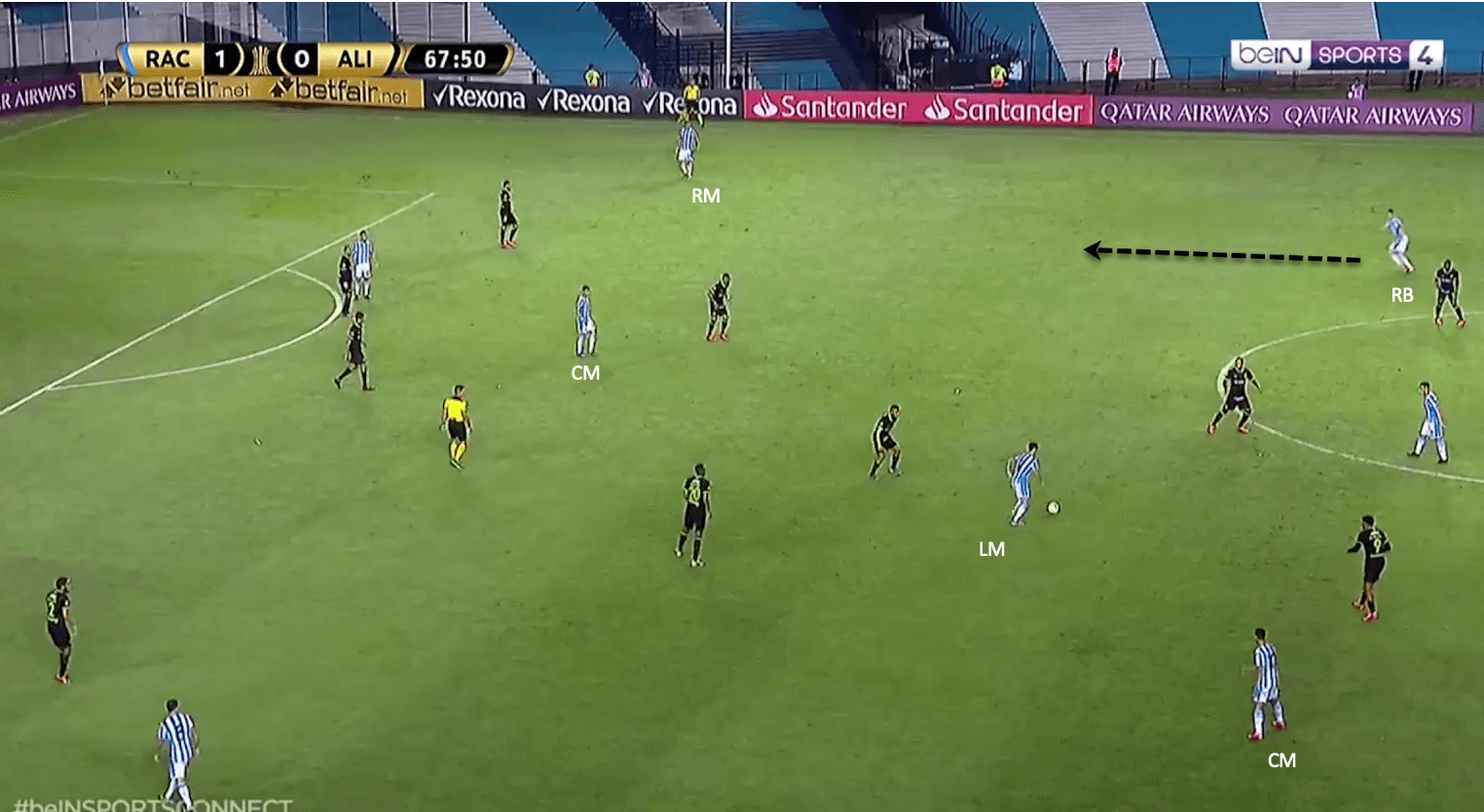
Racing tend to progress the ball through half-spaces a lot, whether it is runs from centre-backs, from full-backs or someone else. Rojas especially likes to receive the ball in half-spaces from centre-backs (you can see that he is positioning himself in that spot in the above picture).
The 4-1-4-1 formation offers Racing a lot of flexibility and opportunities to work with, as we saw in the previous paragraphs. The way all players adapted their roles which require different actions depending on the circumstances makes Racing’s build-up non-linear and very hard to effectively press.
In the next section of this analysis, I will look into the attacking patterns of Racing Club.
Attacking movement
Beccacece improved the attacking output of the team, with Racing scoring 18 goals in 11 games since his arrival, compared to 22 goals in 20 games with Eduardo Coudet. In this section, I will break down several principles that made this transformation possible.
Flank combinations
Having two flank players and a central midfielder in support allows Racing to create triangles on the flanks and, as a result, progress the ball. Beccacece puts emphasis on always having a player in the half-space, whether that is a full-back, central midfielder, wide midfielder, and even occasionally centre-back. You can see one of the ways of players’ positioning as they approach the final third in the shot below. The left-back is in the half-space, with the left midfielder staying wide and with the central midfielder in support. These three players are forming a triangle and through third-man runs and 1-2 combinations, they can progress the ball forward. There are a great variety of ways what players occupy certain spaces. For instance, another option would be the wide midfielder drifting inside, left-back staying wide and central midfielder operating in the half-space (similar to what we saw in the previous section).
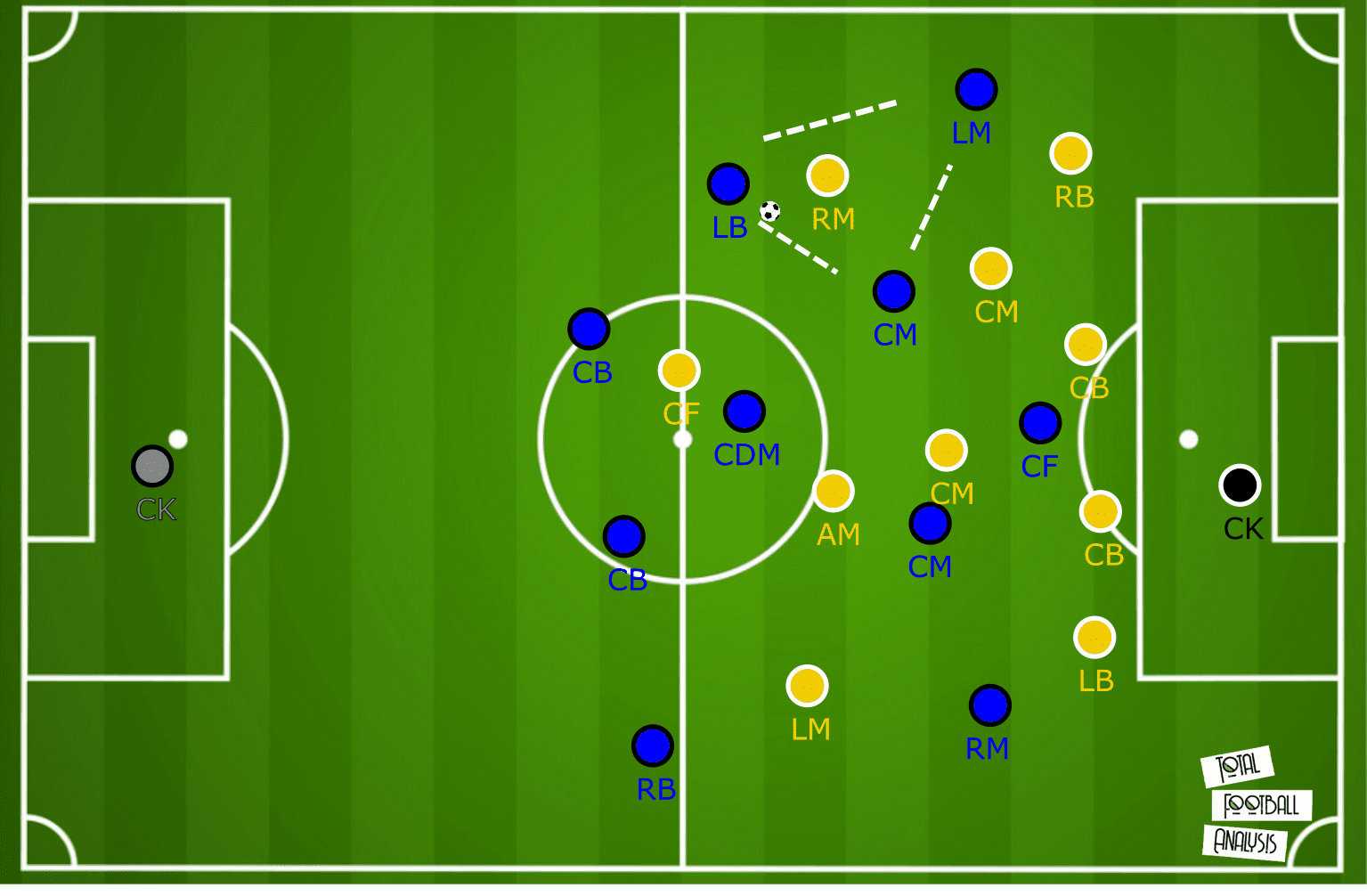
The main goal of this flank-oriented play is to enter the penalty area from the flanks, or play through the centre and then attack from there.
In the image below you can see one of the examples of Racing’s play on the flanks. The central midfielder, Rojas, is in support, and the left-back plays the pass to the wide midfielder who then crosses into the box. When the first attempt of progressing the ball through the flank fails, players try to find options in the centre, where there is always a passing opportunity to get the ball to the forward, or the central midfielder. If playing through the centre is not promising as well, they get the ball back to the same or the opposite flank to try their luck from here.
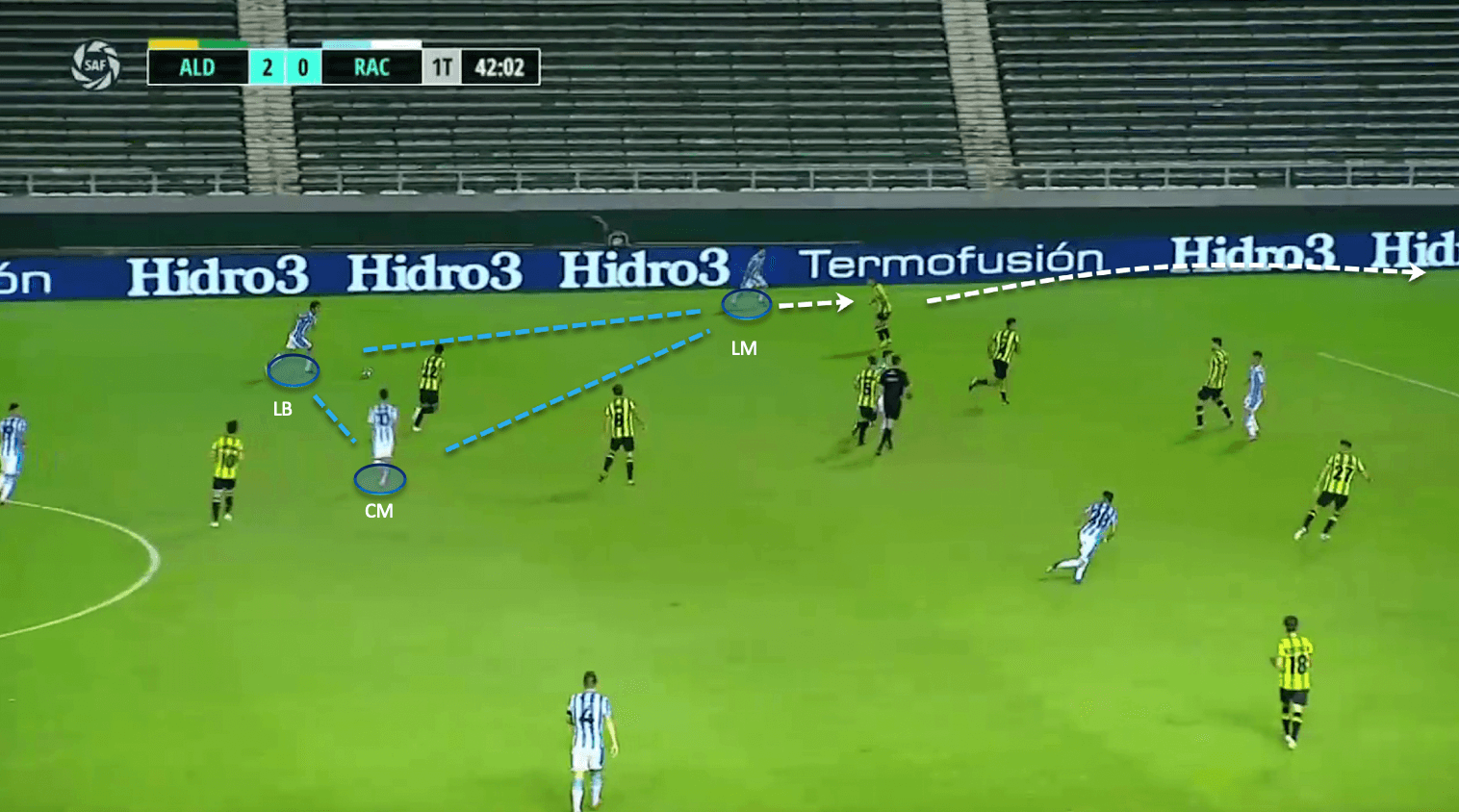
Racing keep the ball 62.35% of the time since Beccacece’s appointment, and it’s no wonder considering the fact that they have been really good in possession. With a well-developed system of play they often find their way into the penalty area.
Long balls
Racing play 60 long balls per game as a team, and it is one of their main weapons against the opposition defence. Benaccacece’s tactics in this area are not only aimed at the long balls and their effect on their own but also on the ability of the players to win second balls and establish possession in the final third.
The wing-players are great at getting the long balls across the pitch and this allows to switch the play and attack unoccupied flank. You can see the example below:
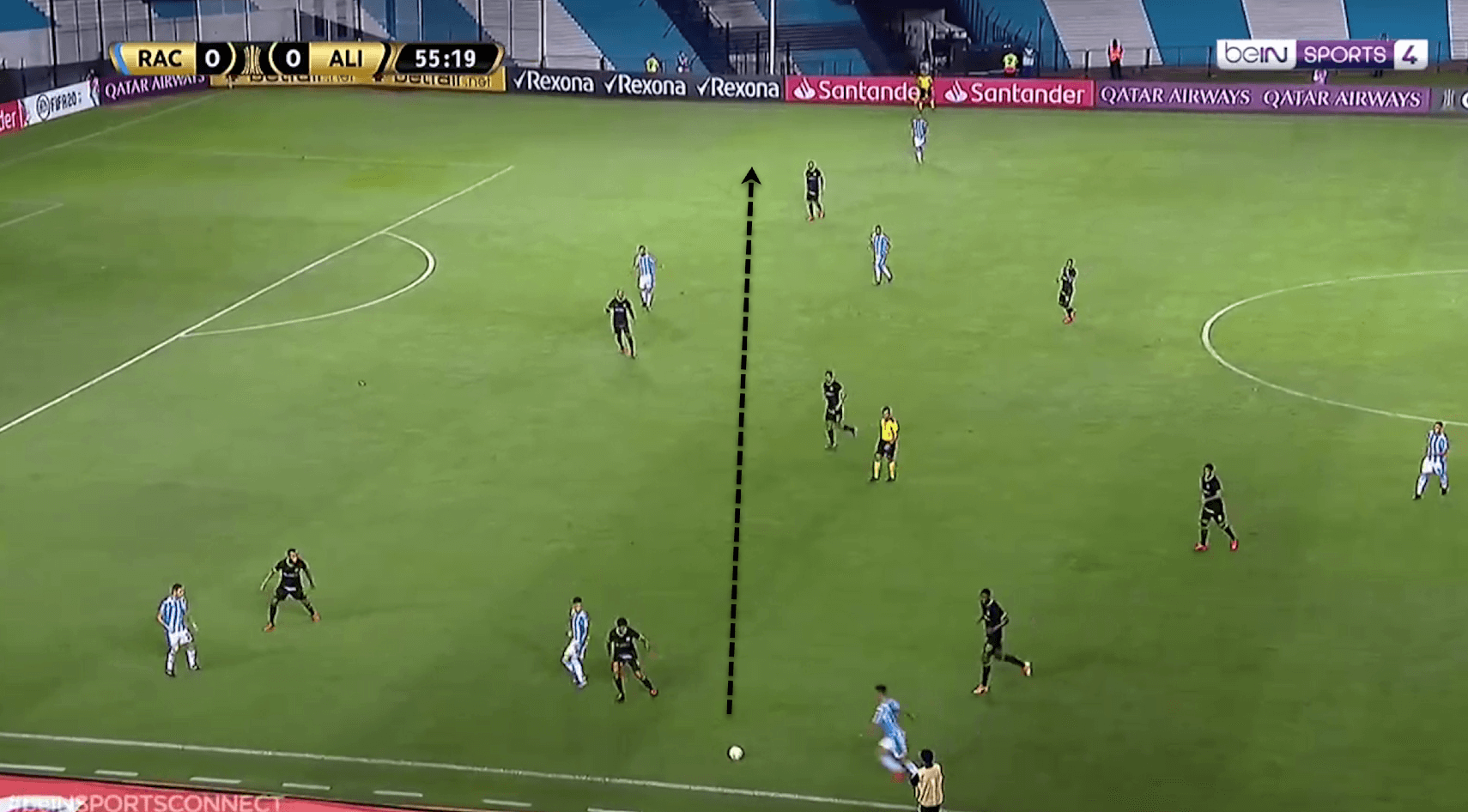
Moreover, playing long balls across the pitch is a great way to open up the opposition defence, and with the right execution, such passes can be secondary assists, like in the shot below, where the pass goes from the left flank over to the right. The compactness of the opposition gives a lot of space for the right back to receive the ball and cross it into the box for the opening goal:
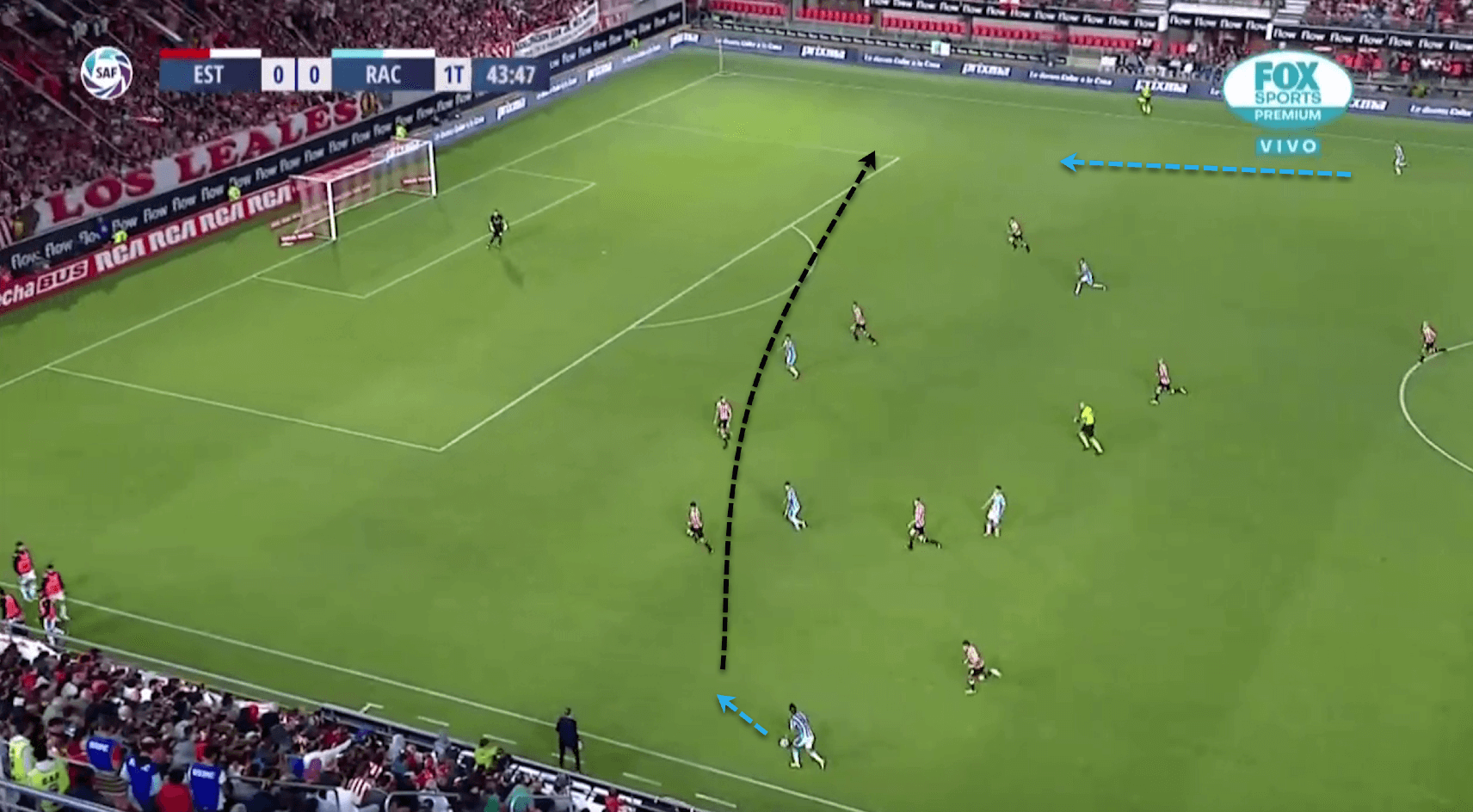
Apart from switches of play, launching long balls into the final third is a frequent occurrence in Racing games. Both central midfielders, Zaracho and Rojas, are agile and can fight for the second balls and counter-press efficiently to get the ball and then lay it off for the arriving teammate. Oftentimes attackers will get near or into the penalty area and then wait for the long ball and then for second balls or counter-pressing opportunities. You can see this pattern in the image below, where four Racing players are staying in line with the defenders for the upcoming pass.
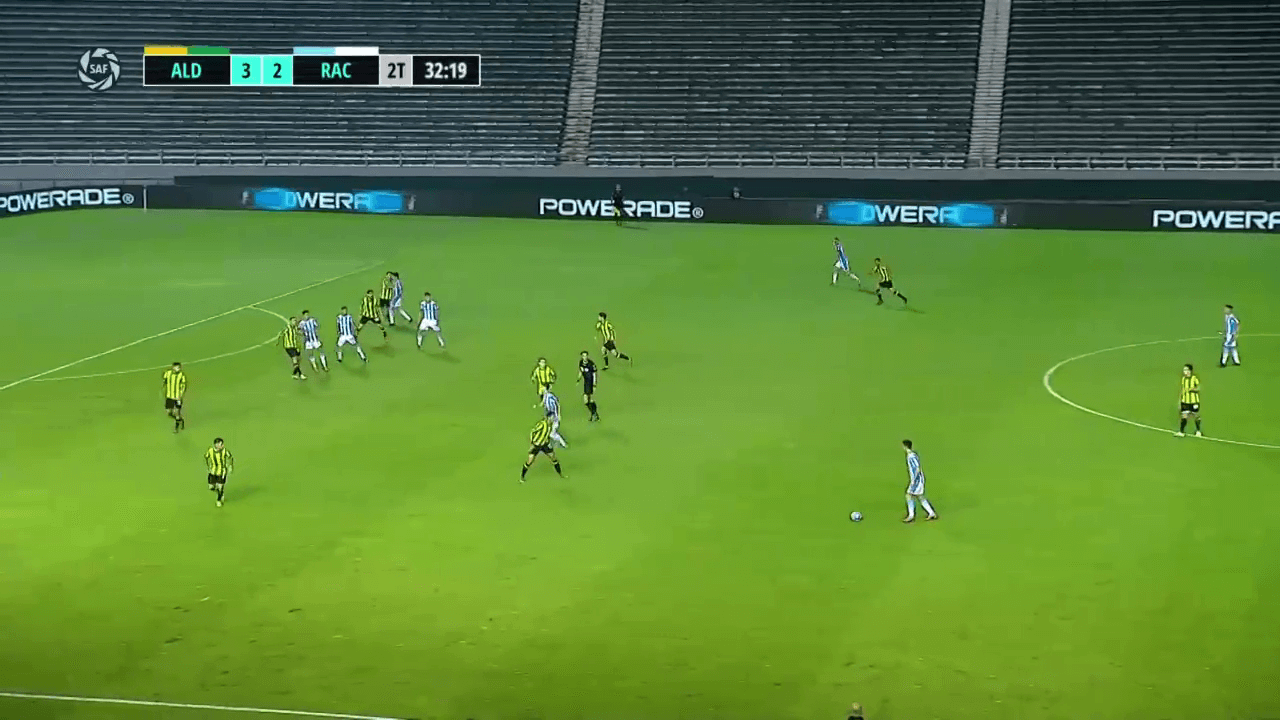
Composure in the box
Like any team, Racing players tend to get to the best shooting positions they can to be in with a good chance to score. However, what differentiates them from other teams is their tremendous composure in front of goal. They work the ball around until it’s clear that there is no better solution than to shoot. All players are cold-minded when approaching the penalty area and that helps them get clear chances despite the game state.
In the shot below you can see a great example of one of the goals scored by Racing in this manner. David Barbona, who is on the ball, plays it through to the left-back Mena ahead of him, and the Chilean has a clear shot on goal himself, but he makes a pass further to Zaracho who finishes a simple tap-in.
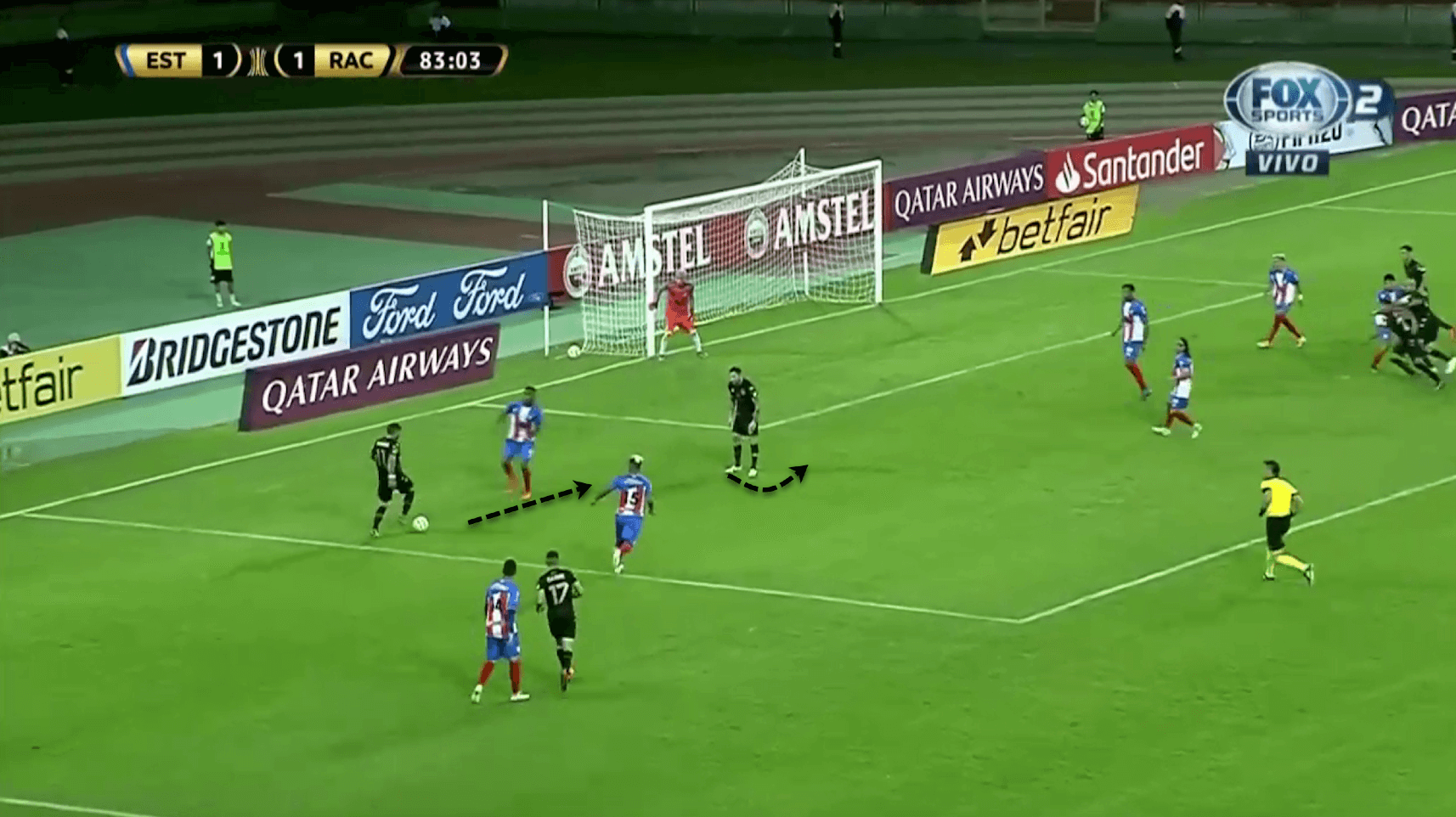
Here is another example of Racing’s brilliant attacking play. After getting the ball at the edge of the penalty area on the right, forward Cvitanich (former Ajax player) drives inside and makes a pass to Miranda who passes the ball between his legs and Marcelo Díaz finishes. The similar thing happened in the game against River Plate back in August, so the team has great chemistry in that regard.
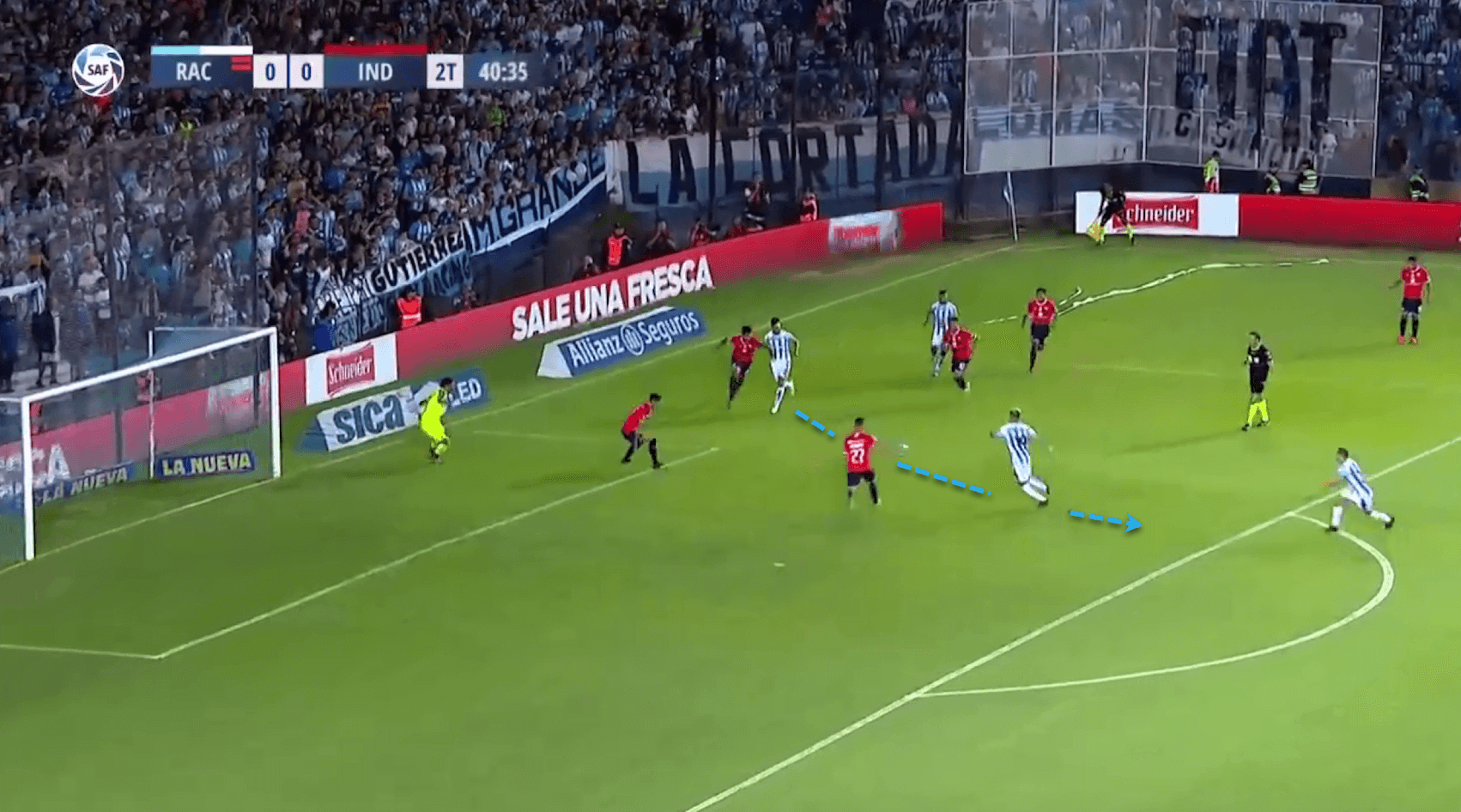
Both of these examples are late minutes goals when there is always a lot of pressure and you oftentimes just try to have a shot, not to mention playing things like in the above examples. The composure and this kind of attacking mentality that Racing players have is a unique one and can come in handy in the future.
Defending
The defensive woes of Racing Club were partly the reason why they missed out on the automatic spot for Copa Libertadores participation. The goal difference between them and Gabriel Heinze’s Velez Sarsfield, who finished in the third position, turned out to be the tie-breaker. Racing conceded the most goals in the top six, equaling exactly one conceded goal per game. In this section of the analysis, I will look into Racing’s defensive organisation.
Racing defend in their basic 4-1-4-1 shape, which gives them a solid cover in the centre and two defending players on the flanks. It seems that Beccacece uses position-oriented zonal marking as his team’s defensive approach. It means that the whole team shifts across the pitch according to the position of the ball as a unit. Racing apply high pressing and try to get the ball back with numbers. By the whole team positioning closer to the area of the ball, players have the opportunity to get the ball back by having several players limiting passing lanes and pressing the player on the ball. It is an effective way of defending in many cases, and it proved to be efficient for Racing. In the shot below you can see how Racing have all their players are on the right side of the pitch with 5v3 on the right flank.
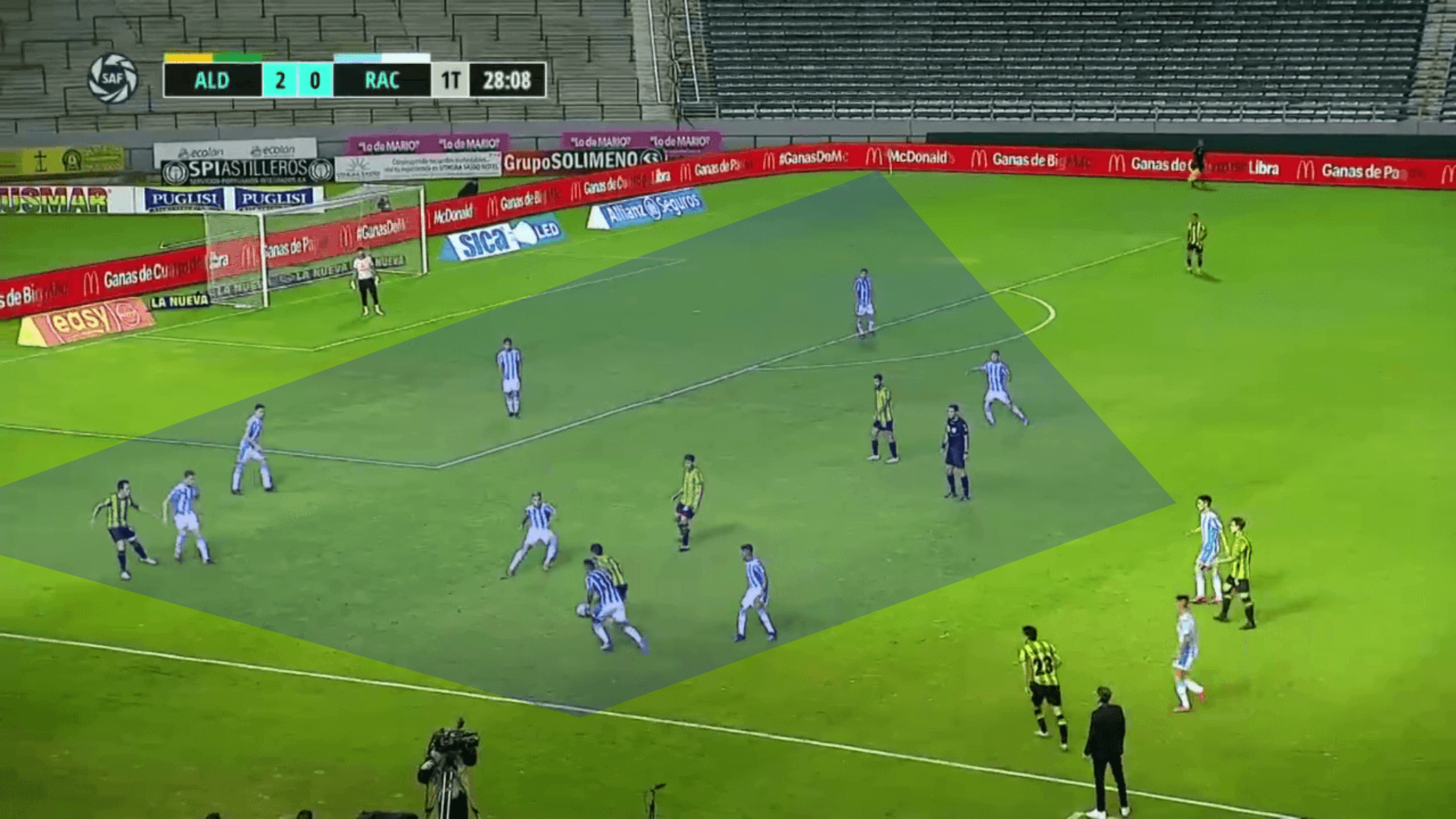
However, with such defensive set up there is always a risk of being exposed if the opposition manage to play through. This happened in their last game against Aldosivi in the seven-goal thriller, where Racing got exposed on the left flank after being unable to win the ball on the right side. You can see this in the image below, where the Aldosivi’s attacker makes a run into the box from the left, while all eyes of Racing players are focused on the ball, and when the opposition plays through the centre, the Beccacece’s team concede. These types of situations are repeatedly occurring and I believe that’s their main defensive concern.
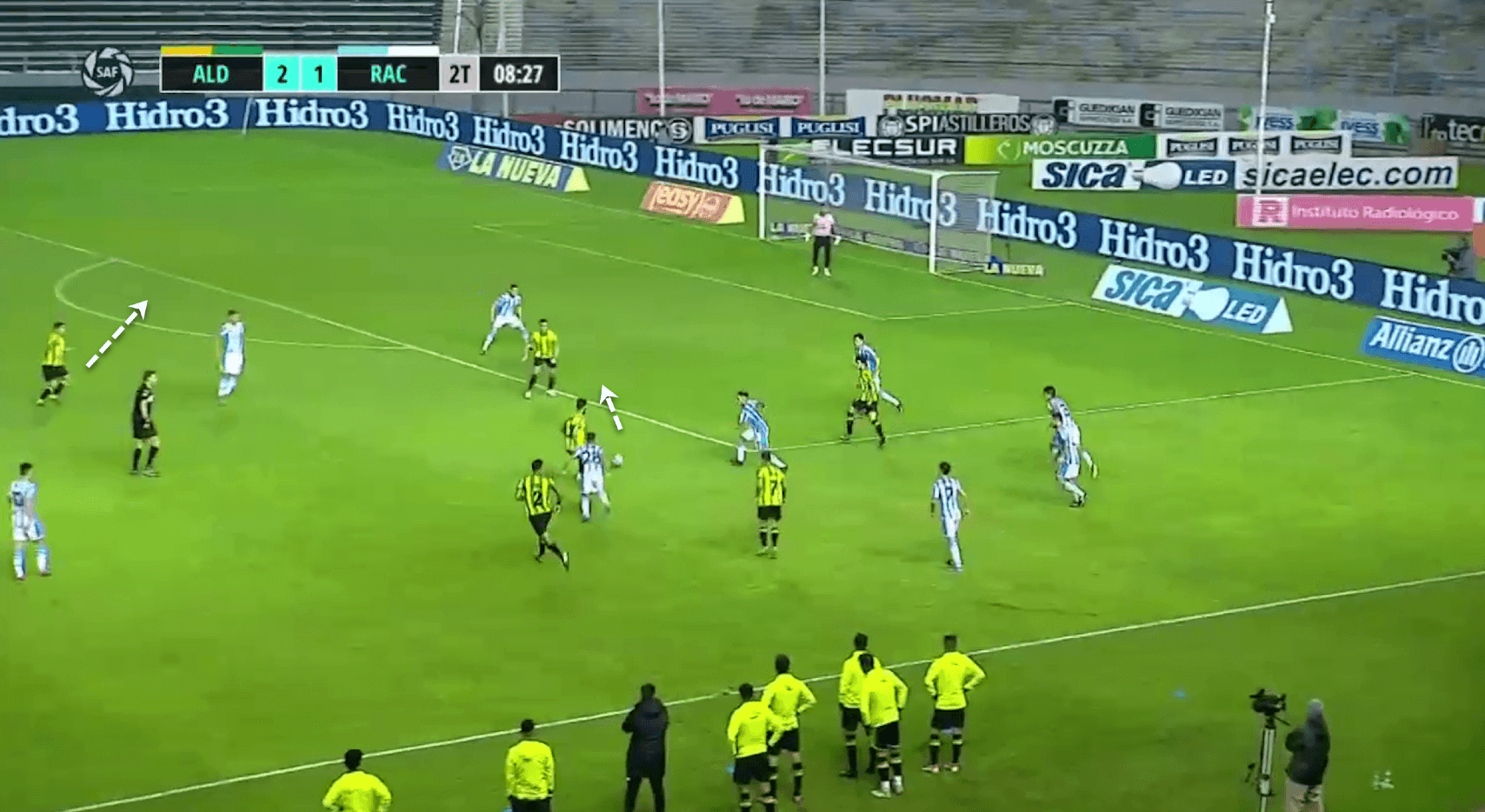
In terms of pressing formation, the striker marks one of the centre-backs, and the other centre-back is marked by one of the midfielders, Zaracho or Rojas. In the shot below you can see the example of this where Rojas joins Lisandro Lopez in the first line of pressing. Zaracho, who is left in the midfield, analyses the body language of the on-ball centre-back and moves closer to the opposition midfielder who is likely to receive the ball. The left midfielder puts pressure on the right-back.
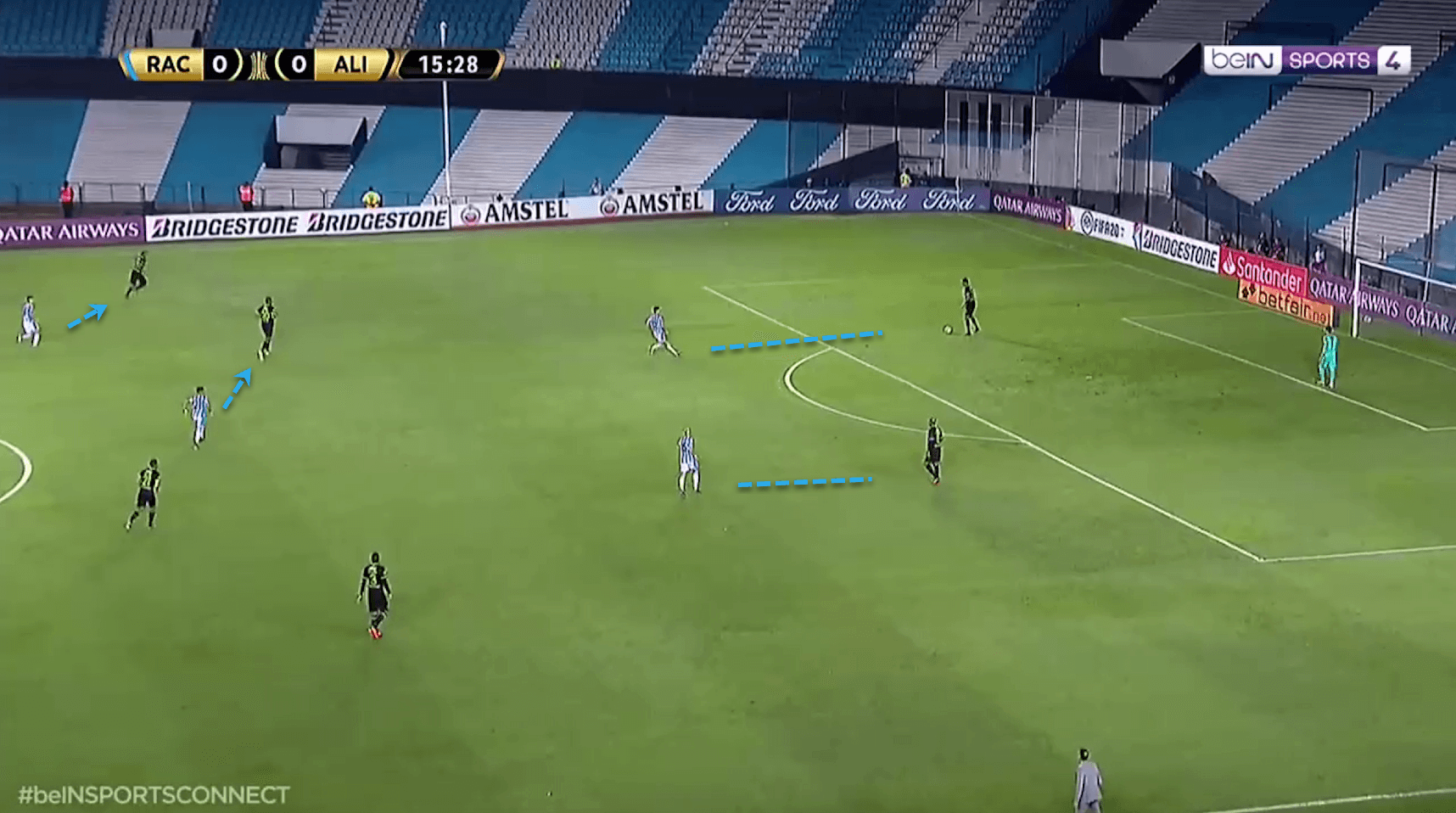
The intelligent movement of Rojas and Zaracho is very important to Racing’s pressing game, as they need to help the striker to press the opposition defence with one of them covering the central zone. In the example below when the opposition full-back gets the ball, Zaracho starts marking the defensive midfielder instead of the centre-back, Fertoli presses the full-back and cuts off the passing lane to the wide player, and Rojas creates a cover shadow for the opposition midfielder.
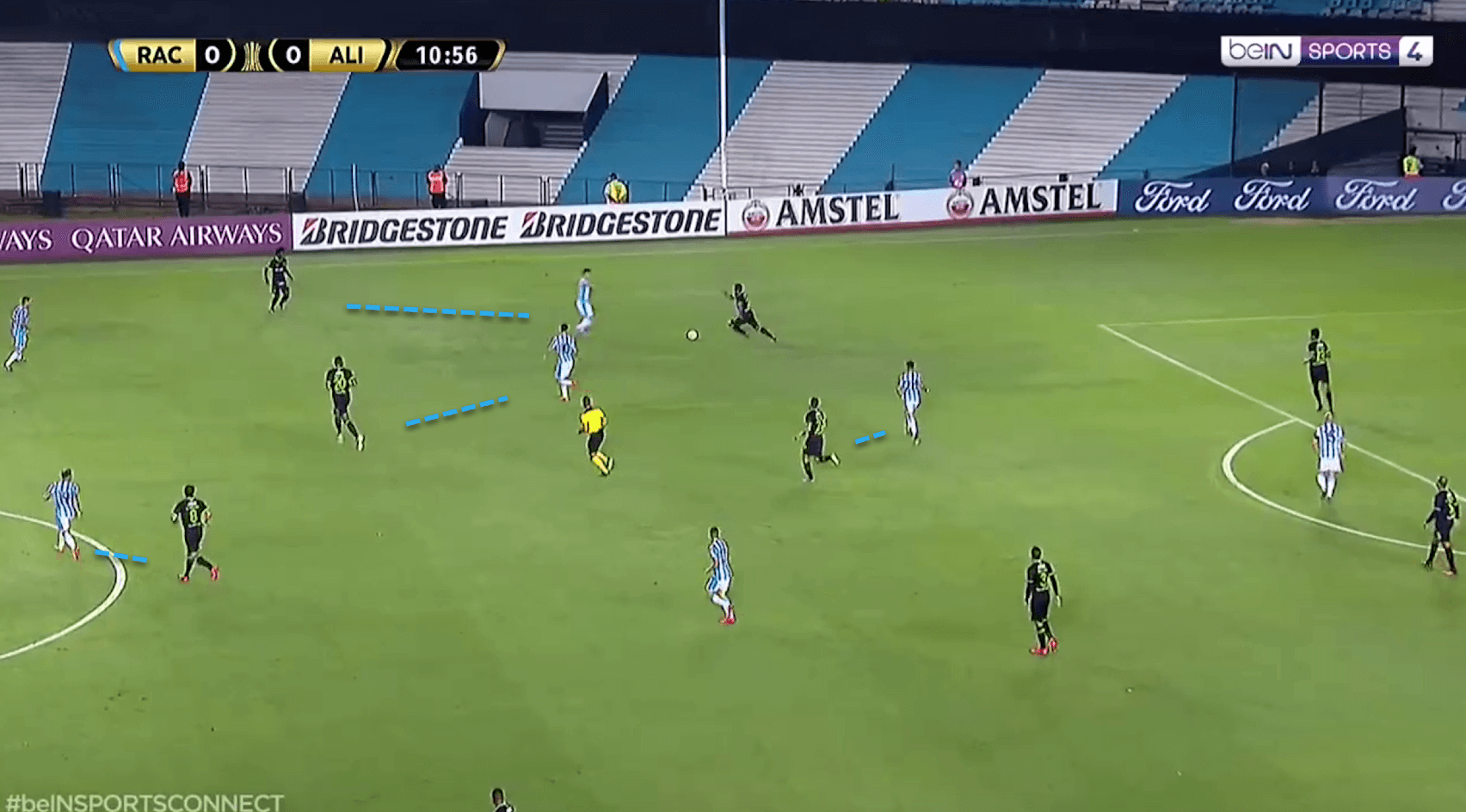
The concept of pressing with numbers applies to all areas on the pitch, with players trying to force the opposition to the touchline, to go long, or to make an unsuccessful passing attempt. Despite some level of flexibility in the final third with marking players, in the middle and defensive third, the defenders and midfielders tend to man-mark the opposing players and press them from the back when they receive the ball. This results in a high number of turnovers for them, and knowing their tendency to have the most time in possession, their high pressing is reasonable.
Racing’s PPDA is on 7,02 which is the sixth result in the league. Their pressing and defensive structures have worked in their favour a lot of times, however, the tendency of being exposed in cases of failed pressing tells that there is room for improvement.
Conclusion
Racing is a great team with a lot of young and promising players. Last year’s success showed that they are capable of performing on the highest level and win trophies. Sebastián Beccacece has been able to implement some of his ideas after just three months and eleven games in charge, and we can expect more tactically-drilled and well-coached team next season. They’ve assembled a good squad with a mixture of talent and experience. For instance with Marcelo Díaz, who has played for Celta in La Liga and with Benjamin Garre joining the team from Manchester City. With the right transfer policy and further improvement, they can become the long-term powerhouse in South American football.
You are going to love what Total Football Analysis are bringing you this weekend.
Starting with the Reiverderby in the German Bundesliga this coming Saturday, May 16 – Total Football Analysis will be bringing you live match commentary and analysis of Borussia Dortmund vs Schalke, kicking off at 14:30 UK.




Comments